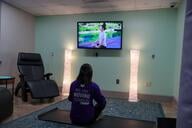You have /5 articles left.
Sign up for a free account or log in.

Ohio State University is scaling its mental health offerings to increase access and support for all students, with a particular focus on graduate students.
Megan Jelinger/AFP
As student mental health needs have grown, more institutional leaders are investing dollars into supporting preventative and interventional measures to aid in student well-being. Ohio’s House Bill 33 allocated $2.5 million to Ohio State University, part of $20 million in funds for university mental health support for students across the state.
University leaders hope to remove barriers to access for students with the funding, particularly for graduate and professional students, through teletherapy, biometric equipment and online resources.
What’s the need: Graduate and professional students face a number of unique life challenges in pursuing their education that vary from their undergraduate peers, including finding social support, navigating life logistics and finances, says Harry Warner, associate director of outreach in Ohio State’s counseling and consultation service (CCS) office.
Incoming undergraduate students often reside in a residence hall surrounded by their peers and experience greater proximity to like-minded individuals. Some graduate students are living alone, with strangers off campus or with their families, making building relationships more difficult, Warner says.
Graduate students can face intense comparison of self to others, burnout and impostor syndrome from rigorous academics and a lack of community.
With age also comes various developmental life markers, further exposing students to new challenges, such as working with a difficult landlord or raising children.
In addition, graduate education can be expensive and have a lower return on investment, which can harm students’ financial wellness and increase stressors while they are enrolled.
Inside Higher Ed’s 2024 Survey of College and University Presidents found three-quarters of institutional leaders believe they have sufficient clinical capacity to meet the mental health needs of graduate students—but presidents of public institutions were less likely to say this was true, with fewer than one quarter somewhat or strongly agreeing.
At Ohio State’s counseling center, around one in four clients are graduate students (slightly higher proportionally than the graduate student rate at the university), but leaders want to further remove barriers to access.
Dollars at work: OSU will allocate funding to establish in-person and remote supports, including training peer mental health ambassadors, offering teletherapy services, hiring a graduate student administrative assistant, purchasing biofeedback equipment and developing online mental health modules.
Teletherapy and digital mental health modules, specifically, will be targeted toward graduate and professional students. Ohio State partnered with Uwill to offer virtual mental health care, which will be available to all students across the university’s five campuses.
Uwill will extend on-campus services, allowing learners to get after-hours care at night and on weekends and access care wherever they are when off campus, Warner says. “Convenience and accessibility are the big pieces there, so that’s a good extension of how we can support students.”
Staff will use the biofeedback machine to help students practice self-soothing and grounding skills by tracking their heart rate or breathing.
“The student gets instant feedback on what the effects … while they’re relaxing, while they’re engaging in progressive muscle relaxation, diaphragmatic breathing, those type of things, and it really helps a person get to a deeper level of relaxation,” Warner says.
The university offers a Mental Health Care Grant, housed within the student advocacy center, that provides up to $2,000 to make mental health services accessible. This money can be applied to fund therapy sessions, medications, transportation or childcare costs associated with participating in therapy. Some of the state dollars will be allocated to this fund, providing further reimbursement for students.
Additionally, students can access a mood-tracking app, WellTrack Boost, for free, thanks to the grant.
A larger focus of care: The new funding works to support OSU’s already existing models of care.
One graduate and professional student–focused initiative is CCS’s embedded counseling program, which places 18 practitioners in 16 academic areas such as the dentistry, pharmacy, law and nursing programs. These providers assist in outreach and preventative education as well as therapy and consultation, and they can be highly impactful due to their proximity to learners, Warner says.
“Having a psychologist over in the College of Optometry does a lot, [because it’s] someone right there that they can talk with [who] understands what they’re going through,” Warner adds.
Graduate students can also benefit from group counseling programs offered by OSU’s counseling and consultation service, which include affinity groups.
One impactful outreach program, also Warner’s favorite, is Let’s Talk, modeled after Cornell University’s intervention, which allows students to have free, confidential, drop-in conversations with counseling staff.
In the past, graduate students have used Let’s Talk sessions to address issues like communicating with their faculty mentor or navigating counseling in the U.S. as an international student. These conversations don’t require intake forms and 10 weeks of sessions, Warner says, but they are important to reaching students who need help addressing their mental health and want to connect with an expert.
Removing barriers is a key focus in graduate student support, because of this population’s competing priorities and limited resources such as time and money. So, Warner adds, any way counseling staff can make it easy and low-stakes to engage with students is important.
Get more content like this directly to your inbox every weekday morning. Subscribe here.




